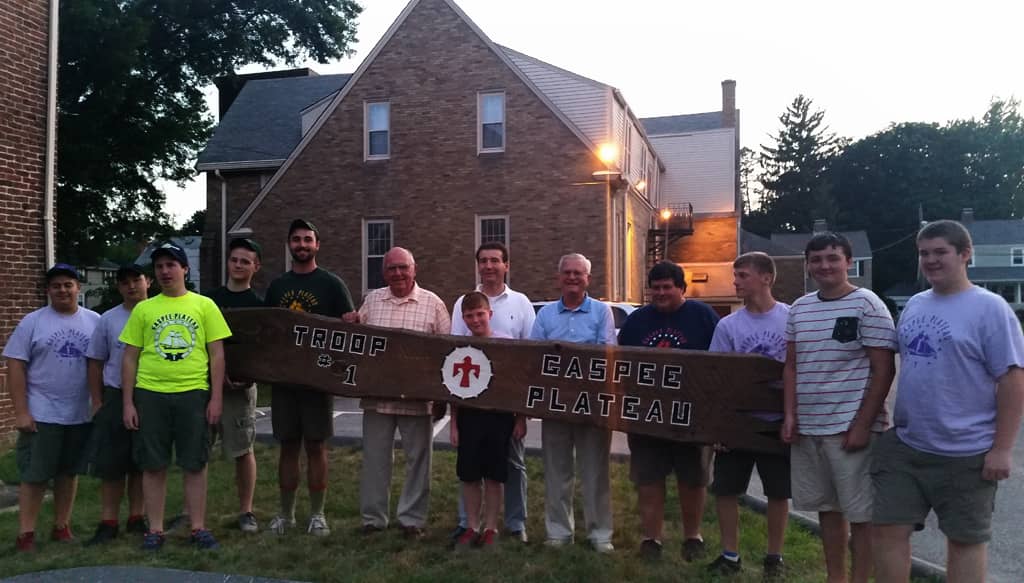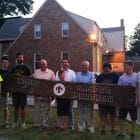
Editor’s note: This story and photography was contributed by Mary Carlos.
Warwick, RI – Troop 1 Gaspee Plateau Scouts Jack Wallace and Everett McEwen were awarded their Eagle Scout badges on April 3, 1948, and on Wednesday, the pair returned to tell the Troop’s modern Scouts some old stories.
Wallace and McEwen are among the Troop’s first 10 Eagle Scouts. Their friend, the late Harry Lefebvre, Jr., received his Eagle Scout badge the same day they did. John Bennett, who earned his in 1937, five years after the troop was formed, was the first Troop 1 Gaspee Eagle Scout.
Eighty-nine boys have made Eagle Scout in the troop’s 83 years.
The 1940s era Scouts, life-long friends, talked about their experiences in Boy Scouts during World War II. Much has changed, but many things have remained the same, they said.
They joined the troop in 1944, near the end of the war, when a week at Camp Yawgoog cost just $12 compared to $395 now, McEwen said. They had to bring rationing stamps to camp for their first two years because many things were still in short supply. Meat stamps were red, dairy were blue, bread and other staples had their own colors, Wallace said.

Then, like today, the boys worked on merit badges, shot bows and arrows and rifles, and swam. On Sunday, the last day of the camp week, families would visit and all the Troops in camp would have a dress parade, they said, a tradition that continues today, said Scoutmaster Gerry Terceiro.
Merit badges were similar, like Wood Carving, Lifesaving, and Camping, Terceiro said, but others, Robotics for instance, have been added over the years.
These days, the Troop goes on six tent camping trips and two cabin trips each year, with New Hampshire mountain climbing and Block Island cycling two of the furthest locations, with the exception of biennial trips to more distant spots like Washington DC and Gettysburg, PA, Terceiro said.
Parents usually carpool to the trips and summer camp today. In the 1940s, many people didn’t have good working vehicles and gas was also rationed. Luckily, one of the scoutmasters had an A card which would allow him to get more gas than those with B or C cards,Wallace said. You could get eight gallons of gas for $1. They would only go on a few camping trips each year, with occasional impromptu trips, and take a bus to summer camp.
McEwen mentioned having to ditch their tents. The original Troop tents didn’t have bottoms, he said, so Scouts would dig a ditch around their tents to prevent water from going under the sides and into the sleeping area. Terceiro said they called it trenching when he was a boy but since the new Troop tents have bottoms, it’s no longer necessary.

Wallace, McEwen, and Lefebvre enjoyed wood carving so much that in 1947 they carved the troop’s sign in Lefebvre’s workshop. That sign, along with the totem poles, is still used today. It’s marked the entrance to Troop 1 Gaspee Plateau’s camp site at Camp Yawgoog for decades.
It’s also used at the Eagle Courts of Honor, ceremonies where new Eagle Scouts are presented with their badges in front of their family and friends. The ceremonies are normally held for just one Scout at a time. In the early years of scouting in Rhode Island, all the Eagle Scouts in Narragansett Council would be awarded their badges at one ceremony at the RI Statehouse, McEwen said.
To reach Eagle Scout rank, each Scout must earn a number of merit badges as well as perform a community service project known as an Eagle Project. Ambitious and hard working Scouts aspiring to Eagle rank can be found organizing clean-ups of local cemeteries and parks, building picnic tables, or collecting and repairing bicycles to donate to foster homes. An Eagle Project wasn’t a requirement in the 1940s, Wallace and McEwen said, but they still had to earn a required number of merit badges. The Eagle Project was made a requirement for Eagle rank in 1965, according to meritbadge.org.
Troop 1 was formed on Sept. 30, 1932 and still meets in the same place, Asbury United Methodist Church, 143 Ann Mary Brown Drive in Warwick. Since then, they’ve moved their meetings from the upper to the lower level of the church.

This is a test





